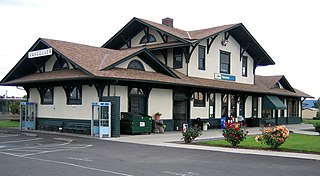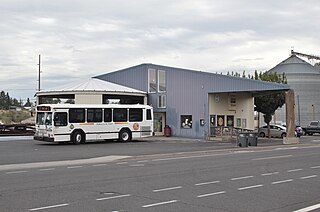
The Empire Builder is a daily long-distance passenger train operated by Amtrak between Chicago and either Seattle or Portland via two sections west of Spokane. Introduced in 1929, it was the flagship passenger train of the Great Northern Railway and was retained by Amtrak when it took over intercity rail service in 1971.

The Hiawatha Service, or simply Hiawatha, is an 86-mile (138 km) train route operated by Amtrak on the western shore of Lake Michigan between Chicago, Illinois, and Milwaukee, Wisconsin. However, the name was historically applied to several different routes that extended across the Midwest and to the Pacific Ocean. As of 2007, twelve to fourteen trains ran daily between Chicago and Milwaukee, making intermediate stops in Glenview, Illinois; Sturtevant, Wisconsin; and Milwaukee Mitchell International Airport. The line is partially supported by funds from the state governments of Wisconsin and Illinois. The line utilizes the CPKC Railway's C&M Subdivision and Metra's Milwaukee District North Line.

The Coast Starlight is a long-distance passenger train operated by Amtrak on the West Coast of the United States between Seattle and Los Angeles via Portland and the San Francisco Bay Area. The train, which has operated continuously since Amtrak's formation in 1971, was the first to offer direct service between Seattle and Los Angeles. Its name is a combination of two prior Southern Pacific (SP) trains, the Coast Daylight and the Starlight.

Saint Paul Union Depot is a historic railroad station and intermodal transit hub in the Lowertown neighborhood of Saint Paul, Minnesota. It serves light rail, intercity rail, intercity bus, and local bus services.

The North Coast Limited was a named passenger train operated by the Northern Pacific Railway between Chicago and Seattle via Bismarck, North Dakota. It started on April 29, 1900, and continued as a Burlington Northern Railroad train after the merger on March 2, 1970 with Great Northern Railway and the Chicago, Burlington and Quincy Railroad. The next year, it ceased operations after the trains which left their originating stations on April 30, 1971, the day before Amtrak began service, arrived at their destinations.

The North Coast Hiawatha was a long-distance passenger train operated by Amtrak between Chicago, Illinois, and Seattle, Washington.

Midway is a former Amtrak intercity train station in the Midway neighborhood of Saint Paul, Minnesota, United States. It was last served by Amtrak's daily Empire Builder and, for a time, by the North Star, as well as briefly by the North Coast Hiawatha.

Vancouver station is an Amtrak intercity rail station in Vancouver, Washington, United States. The station is served by four daily round trips of the Cascades, the daily Coast Starlight, and the daily Portland section of the Empire Builder.

The Olympian and its successor the Olympian Hiawatha were passenger trains operated by the Chicago, Milwaukee, St. Paul and Pacific Railroad between Chicago and the Pacific Northwest. The Olympian operated from 1911 to 1947 and was, along with its running mate the Columbian, the first all-steel train to operate in the Pacific Northwest. The streamlined Olympian Hiawatha operated from 1947 to 1961 and was one of several Milwaukee Road trains to carry the name "Hiawatha". The Olympian Hiawatha was designed by industrial designer Brooks Stevens and included the distinctive glassed-in "Skytop" observation-sleeping cars. It later featured full-length "Super Dome" cars.

Ephrata is a train station on Amtrak's Empire Builder line in Ephrata, Washington. The station and parking are owned by the city government, while the track and platforms are owned by BNSF Railway. Northwestern Trailways provides inter-city bus transportation next to the station while local transit is provided by the Grant Transit Authority.

Columbia Station, also known as Wenatchee station, is an intermodal train and bus station in Wenatchee, Washington, United States. It is a stop on Amtrak's Empire Builder train and is the main hub for Link Transit, the local bus system serving Wenatchee and surrounding areas. The station is also served by intercity buses operated by Grant Transit Authority, Northwestern Trailways, and Travel Washington.

The Northern Transcon, a route operated by the BNSF Railway, traverses the most northerly route of any railroad in the western United States. This route was originally part of the Chicago, Burlington and Quincy Railroad, Northern Pacific Railway, Great Northern Railway and Spokane, Portland and Seattle Railway systems, merged into the Burlington Northern Railroad system in 1970.

La Crosse station is an Amtrak intercity train station in La Crosse, Wisconsin, served by the daily Borealis and Empire Builder. The station was built in 1926–27 by the Chicago, Milwaukee, St. Paul, and Pacific Railroad, replacing an older station that burned in 1916. The station was listed on the National Register of Historic Places as the Chicago, Milwaukee and St. Paul Railway Depot and was renovated in 2001.

St. Cloud station is an Amtrak intercity train station in St. Cloud, Minnesota, United States. It is served by the daily Empire Builder on its route connecting Chicago, Illinois to Seattle, Washington and Portland, Oregon. The next stop westbound is Staples while the next stop eastbound is Saint Paul Union Depot.

The Twin Cities Hiawatha, often just Hiawatha, was a named passenger train operated by the Chicago, Milwaukee, St. Paul and Pacific Railroad, and traveled from Chicago to the Twin Cities. The original train takes its name from the epic poem The Song of Hiawatha by Henry Wadsworth Longfellow. There are a number of Hiawatha-themed names within the city of Minneapolis, the terminus of the original train. The first Hiawatha ran in 1935; in 1939 the Milwaukee Road introduced a second daily trip between Chicago and Minneapolis. The two trains were known as the Morning Hiawatha and Afternoon Hiawatha, or sometimes the AM Twin Cities Hiawatha and PM Twin Cities Hiawatha. The Milwaukee Road discontinued the Afternoon Hiawatha in 1970 while the Morning Hiawatha continued running until the formation of Amtrak in 1971.

The North Star was a passenger train operated by Amtrak between Duluth, Minnesota and Saint Paul, Minnesota. It originally operated from Chicago, Illinois via St. Paul to Superior, Wisconsin and Duluth, but was soon cut back to a Saint Paul–Duluth train. The service relied in part on funding from the state of Minnesota.

The Borealis, referred to as Twin Cities–Milwaukee–Chicago (TCMC) during planning, is an Amtrak inter-city rail service that operates daily between Chicago, Illinois, and Saint Paul, Minnesota, via Milwaukee, Wisconsin. The first service began on May 21, 2024, under the Amtrak Midwest brand.

The Butte Depot is a Northern Pacific Railway train station in Butte, Montana, built in 1906. It originally served both the Northern Pacific and Union Pacific railroads. In 1970 the NP merged with the Chicago, Burlington and Quincy Railroad, Great Northern Railway, and Spokane, Portland and Seattle Railway, forming the facility's new owner, the Burlington Northern Railroad; passenger train service was taken over by Amtrak in 1971. In 1979 Amtrak discontinued the North Coast Hiawatha due to budget cuts, leaving the Empire Builder on the former Great Northern Railway line, as the only passenger rail service through Montana.

Glendive Depot is an office building and former train station in Glendive, Montana. The Northern Pacific Railway established the town in 1881 and opened the first depot in 1882. The present depot building was built in 1922 and is part of the Merrill Avenue Historic District.

Bozeman Depot is a former train station in Bozeman, Montana, opened in 1883 by the Northern Pacific Railway. The current brick station house was built in 1892 and expanded in 1924.





















